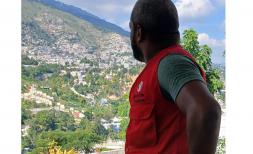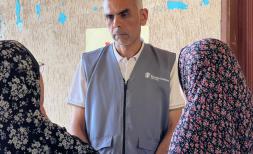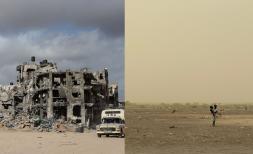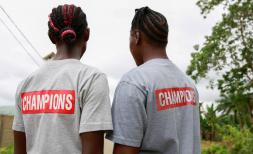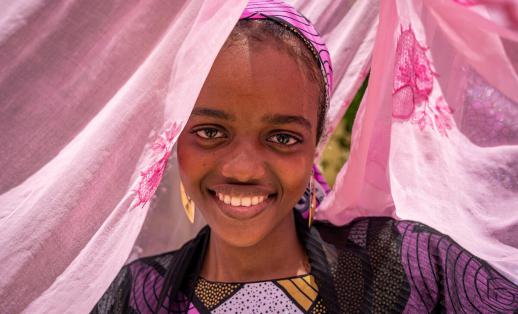Leaving no one behind: Universal Health Coverage agenda at UN General Assembly must deliver action on lifesaving vaccines
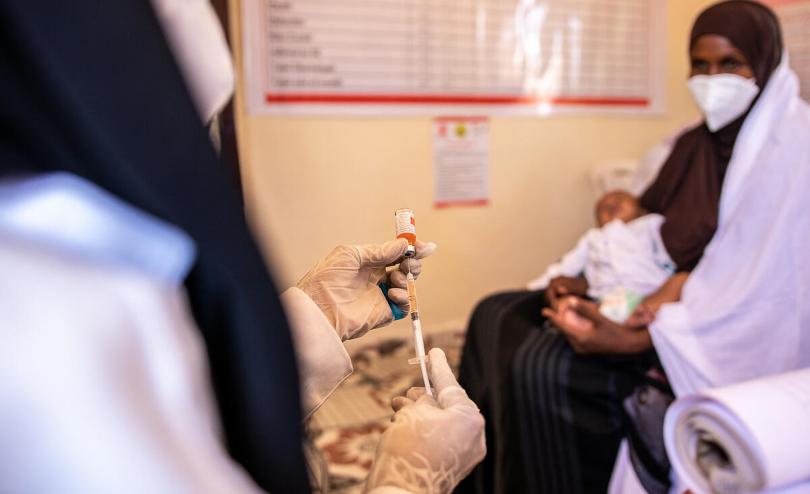
A Save the Children nurse prepares to vaccinate Abdirahman (3 months) while his mother Lucky (29) holds him. Save the Children.
Even though effective vaccines and low-cost treatment have been available for decades, pneumonia and diarrhoea remain the biggest killers of children under 5 years of age. Every hour, more than 140 children die from pneumonia and diarrhoea - a devastating 1.2 million largely preventable deaths annually[1].
The majority of these deaths occur in African countries with relatively low resources, under-resourced healthcare systems, and ongoing conflicts.
Preventing this tragic loss of children’s lives is possible by making sure that two types of common vaccines are available and accessible to children everywhere: the pneumonia-fighting Pneumococcal Conjugate Vaccine (PCV) and the diarrhoea-treating Rotavirus Vaccine (RVV). However, in 2021, just 51% of children globally received PCV and only 49% were given RVV[2]. It doesn’t have to be this way.
As global leaders meet in New York this week as part of the United Nations General Assembly (UNGA) High-Level Week, with the stated aim of putting “the 17 Sustainable Development Goals (SDGs) back on track”, it’s clear that more urgent action and investment are needed to scale-up access to life-saving vaccines.By addressing this issue now, we will be able to accelerate progress towards the Sustainable Development Goal of reducing under 5 mortality rates in every country to 25 or fewer deaths per 1,000 live births by 2030.
By the numbers: vaccines save lives
- 54 –countries with high under 5 mortality rates that are currently set to miss the child survival SDG 3.2 target by 2030, including Somalia and South Sudan
- 112 – children out of every 1,000 born in Somalia who die before reaching their fifth birthdays. In South Sudan, the figure is 99 for every 1,000 children born[3].
- 111,000 – the number of children lost every year in Somalia (80,000) and South Sudan (31,000), mostly to preventable diseases [3].
- PCV and RVV vaccines have the potential to avert more than a million cases of pneumonia, meningitis, and diarrhoea among children between 2024 and 2030 in Somalia and South Sudan[4].
Their use could help reduce suffering among children and the weakening oftheir immune systems due to repeated episodes of pneumonia and diarrhoea. They can also lower the risk of malnutrition and poor growth and development outcomes. Averting cases of pneumonia and diarrhoea will also reduce the financial burden on families and local healthcare systems.
Furthermore, according to the International Vaccine Access Centre’s Lives Saved Tool analysis, introducing and scaling up PCV and RVV vaccines could potentially save the lives of almost 19,500 children in Somalia and 7,000 children in South Sudan by 2030[4].
Unfortunately, both Somalia and South Sudan are yet to introduce the PCV and RVV innational immunization programmes.
Children in these countries should not have to wait for almost two decades to have access to lifesaving vaccines against pneumonia and diarrhoea. The global health community must step up to deliver this now.
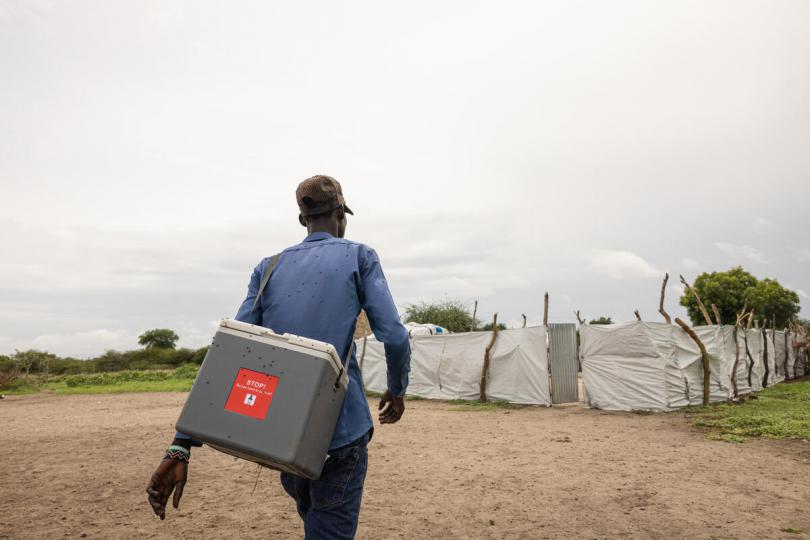
Community health worker Kim carriess a cold box storing vaccines to a remote community in Akobo West, South Sudan. Save the Children
Our work so far
Save the Children’s Pneumonia Centenary Commitment (2017-2022) focused on pneumonia control measures in Somalia and South Sudan to improve diagnosis, treatment and access to care. As part of this effort, Save the Children has worked with partners for changes to global vaccine introduction policies in fragile and conflict-affected countries,and successfully advocated for a waiver of Gavi’s co-financing requirement for the introduction of PCV vaccines in Somalia and South Sudan.
Save the Children also supported advocacy efforts to include pneumonia into the larger child survival agenda during the first and second Global Forum on Childhood Pneumonia in 2020 and 2023, and convened the Global Steering Committee on Pneumonia and Pneumococcal Conjugate Vaccine sub-group to voice the rights of millions of children to have access to lifesaving vaccines in countries facing conflict and fragility.
Nationally in South Sudan, Save the Children worked with the health ministry to develop South Sudan’s first Child Health Strategy, updated Integrated Management of Newborn and Childhood Illness (IMNCI) and nutrition guidelines to include pneumonia, and supported IMNCI roll out and training.
In Somalia, Save the Children supports primary healthcare projects in 14 out of 18 regions with projects to reach zero dose children, providing technical support for the national Expanded Programme on Immunization (EPI) and the integration of Covid-19 vaccinations in routine immunization programmes.
In Somalia, in collaboration with the health ministry and London School of Hygiene and Tropical Medicine UK, Save the Children is also implementing the Evaluating Strategies for Pneumococcal Immunization Campaigns in Crises (ESPICC) study to identify optimal vaccination strategies for children affected by humanitarian crises and use learning from the Pneumococcal Conjugate Vaccine campaign to support the introduction in 2024.
Supporting the introduction of vaccines in Somalia and South Sudan
Over the last few years, the governments of Somalia and South Sudan have shown decisive leadership and commitment for the introduction of the Pneumococcal Conjugate Vaccine and the Rotavirus vaccine.
Through the Pneumonia Centenary Commitment effort and beyond, Save the Children is working closely with the health ministries in Somalia and South Sudan and partners to ensure that introduction and scale up of the vaccines is achieved in 2024.
Save the Children along with the Mérieux Foundation, Every Breath Counts, Malaria Consortium, and the International Vaccine Access Center, broughtthe health ministries of Somalia, South Sudan, Chad, and Guinea together for an “Introducing PCV and Rotavirus vaccine” workshop from 13-15th September in N’Djamena, Chad, to brainstorm strategies to address financing, procurement, vaccine delivery, and health workforce capacity challenges for PCV and RVV introduction.
This is what translating commitments for delivering on child survivalinto action looks like.
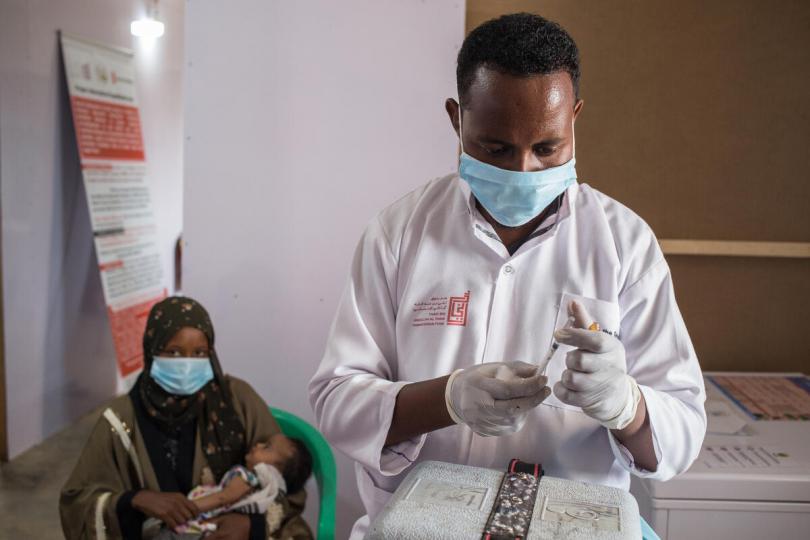
Health worker Ahmed vaccinates a child - MHC, Burao Somalia. Mustafa Saeed/Save the Children.
A global call
While progress is being made by Save the Children and our partners, it is essential that global leaders at the UNGA ensure every dialogue, every declaration keeps child survival at its core. All representatives should strive to translate high-level policies into tangible actionsfor children at national and sub-national levels.
Children in countries such as Somalia and South Sudan need the global health community to come together and gear-up the implementation of Universal Health Coverage to achieve the child survival Sustainable Development Goal. Access to lifesaving vaccines for every child, everywhere is a key part of this – and what’s more, it’s fully achievable.
References
Global, regional, and national causes of under-5 mortality in 2000–19: an updated systematic analysis with implications for the Sustainable Development Goals, Lancet Child Adolescent Health 2022.
UN Inter-agency Group for Child Mortality Estimation 2022.
International Vaccine Access Centre, Johns Hopkins Bloomberg School of Public Health estimates of lives saved & cases averted from introducing PCV & RV in Chad, Guinea, Somalia and South Sudan using the LiST toolunder Global Advocacy for PCV (GAP) Project, June 2023.
